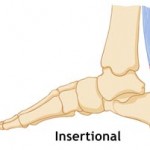Heel pain causes all kinds of problems affecting day to day activities like walking, running and can even disturb sleep. Foot and ankle pain is a very common problem. The heel bone is the largest bone in the foot and it absorbs most of the impact when we are walking and running.
Pain is usually felt at the back of the heel or underneath it, and can really affect daily life. It usually settles down fairly quickly, but even in prolonged cases, heel pain is very rarely a serious issue. In most cases sore heels develop gradually over time but occasionally they can be a result of an injury. Heel pain often causes secondary ailments due to a change in gait to alleviate the pain.
Plantar Fasciitis
 The plantar fascia is a thick band of tissue on the sole of the foot. Damage to it is most common of all foot pain causes affecting one in 10 people.
The plantar fascia is a thick band of tissue on the sole of the foot. Damage to it is most common of all foot pain causes affecting one in 10 people.
- What is it: Damage and inflammation of the plantar fascia
- Causes: Overuse is the main reason for developing plantar fasciitis
- Symptoms: Pain and tenderness under the heel and along the bottom of the foot to the metatarsals that is worse after rest, when standing on tiptoes or going up stairs.
- Associated Problems: The formation of a bone spur.
Achilles Tendonitis
 Achilles tendonitis is the most common of all back of heel pain causes.
Achilles tendonitis is the most common of all back of heel pain causes.
- What is it: Inflammation or degeneration of the Achilles tendon which connects the calf muscle to the heel bone.
- Causes: Repetitive strain on the tendon usually from muscle weakness and/or tightness of the calf muscle.
- Symptoms: Pain in the back of the heel that is worse after rest and first thing in the morning. Ankle or calf stiffness is also commonly reported.
- Associated Problems: Calcaneal bursitis, which is an inflammation of the fluid filled sac that sits between the Achilles tendon and the heel bone.
Bone Spurs
Calcaneal bone spurs can occur both underneath and at the back of the heel. They are very common foot and ankle pain causes.
- What is it: Bony lumps that stick out and are formed by excessive calcium deposits on the bone. Occurring both at the back of the heel or underneath the heel.
- Causes: Repetitive overuse for example, running and jumping, or muscle weakness and/or tightness.
- Symptoms: Bone spurs are often linked to Achilles tendonitis and plantar fasciitis.
Heel Fractures
- What is it: A single or multiple break or crack in the heel bone.
- Causes: Repetitive overloading of the heel, for example, jumping or running causing stress fractures, or a fall from a decent height where you land feet first.
- Symptoms: Pain is made worse by pressure through the heel and swelling. Fractured heel pain causes you to walk differently.
Bursitis
- What is it: Retrocalcaneal bursitis is inflammation of a small fluid sac called the bursa that sits between the heel bone and the Achilles tendon.
- Causes: Repetitive friction on the bursa usually caused by muscle tightness and weakness, or a sudden increase in activity levels.
- Symptoms: Pain in the back of the heel especially when walking, running and standing on your tiptoes. Swelling, redness and warmth at the back of the heel.
- Associated Problems: Commonly associated with Achilles tendonitis.
Tarsal Tunnel Syndrome
Tarsal tunnel is exactly the same as carpel tunnel syndrome that affects your wrists. Carpal defines bones in the hand and tarsal defines bones in the feet.
- What is it: Compression of the tibial nerve as it passes through the tarsal tunnel on the inner side of the ankle.
- Causes: Anything reducing the space in the tarsal tunnel such as swelling, cysts, ganglions, arthritis or flat feet.
- Symptoms: Heel pain that can spread up the calf. Numbness and pins and needles on the inner side of the foot and heel, hot and cold feelings in the foot. Worse at night and usually only affects one foot.
Sever’s Disease
Sever’s Disease is the most common of all heel pain causes in children.
- What is it: Inflammation on the growth plate of the heel.
- Causes: Growth spurt where the heel bone grows faster than the surrounding muscles and ligaments, standing for long periods, and overuse from participating in lots of sporting activities like running and jumping.
- Symptoms: Pain in the heel usually at the back or underneath the heel. Inflammation and tenderness, pain when walking and ankle stiffness. Symptoms are worse with activity and improve with rest. Often affects both feet at the same time.